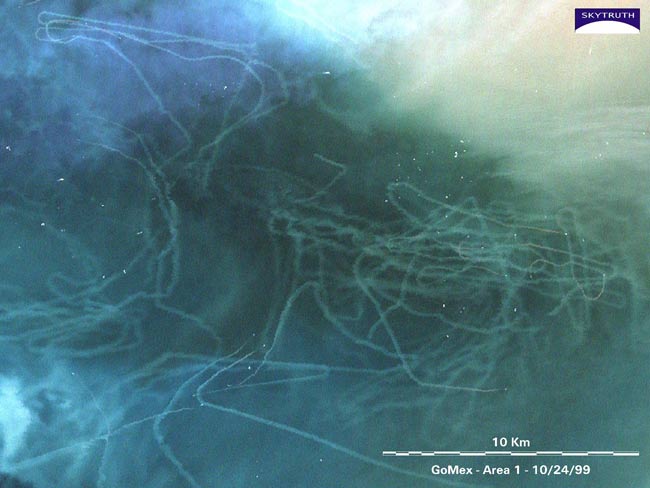Devastation of Trawling Visible from Space

Bottom trawling for fish stirs up billowing plumes of sediment that can be seen from space and destroys entire seafloor ecosystems, new imagery reveals. The technique, used all over the world, is a way to catch fish in deeper parts of the ocean with huge, deep nets, now that many near-shore fish populations have been virtually wiped out from over-fishing. Several studies have shown the significant impact that trawling has on ecosystems, killing corals, sponges, fish and other animals. New and previously released satellite images show the extent of the plumes of material kicked up. And a video of the seafloor reveals how trawling denudes an underwater world. "Bottom trawling is the most destructive of any actions that humans conduct in the ocean," said zoologist Les Watling of the University of Hawaii. "Ten years ago, Elliott Norse [of the Marine Conservation Biology Institute] and I calculated that, each year, worldwide, bottom trawlers drag an area equivalent to twice the lower 48 states. Most of that trawling happens in deep waters, out of sight. But now we can more clearly envision what trawling impacts down there by looking at the sediment plumes that are shallow enough for us to see from satellites." Watling presented his findings Friday at the annual meeting of the American Association for the Advancement of Science in Boston. Persistent plumes As nets are dragged across the seafloor, they can crush coral reefs, drag boulders across the bottom, and trap fish and animals not intended to be caught, called bycatch. All this activity stirs up sediments from the seafloor, which create the persistent plumes in the wake of the fishing ships. Watling and his colleagues say that the plumes visible in satellite images are likely just the "tip of the iceberg" as most trawling is in waters that are deep enough that the plume remains hidden by the water above. "Bottom trawling repeatedly plows up the seafloor over large areas of the ocean," said fellow presenter John Amos of SkyTruth, a digital mapping non-profit group aimed at environment issues based in West Virginia. (Images of these plumes can be seen on the group's website.) Bans and restrictions Scientific studies showing the impacts that trawling has on ecosystems have led to increasing restrictions on the practice. In 2005, the General Fisheries Commission for the Mediterranean banned trawling there below depths of 1,000 meters (3, 289 feet). The United States closed large deep-sea areas off the coast of Alaska to bottom trawling in 2006. Many South Pacific nations have also put a stop to the practice, and the United Nations began deliberations on a trawling moratorium in the high seas in 2006. But there are still tens of thousands of trawlers operating in the Gulf of Mexico, off the coast of many Latin American countries, off the west coast of Africa, in Chinese waters, and the North Sea. "We're a long way from protecting the ocean floor from bottom trawling," Norse told LiveScience.
- Video: Bottom Trawling — A Tale of Two Sites
- The Hand of Man: No Seas Remain Pristine
- Images: Life Under the Sea
Sign up for the Live Science daily newsletter now
Get the world’s most fascinating discoveries delivered straight to your inbox.

Andrea Thompson is an associate editor at Scientific American, where she covers sustainability, energy and the environment. Prior to that, she was a senior writer covering climate science at Climate Central and a reporter and editor at Live Science, where she primarily covered Earth science and the environment. She holds a graduate degree in science health and environmental reporting from New York University, as well as a bachelor of science and and masters of science in atmospheric chemistry from the Georgia Institute of Technology.









